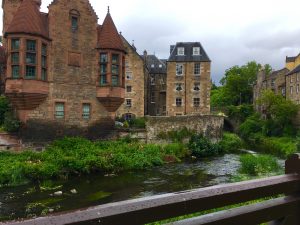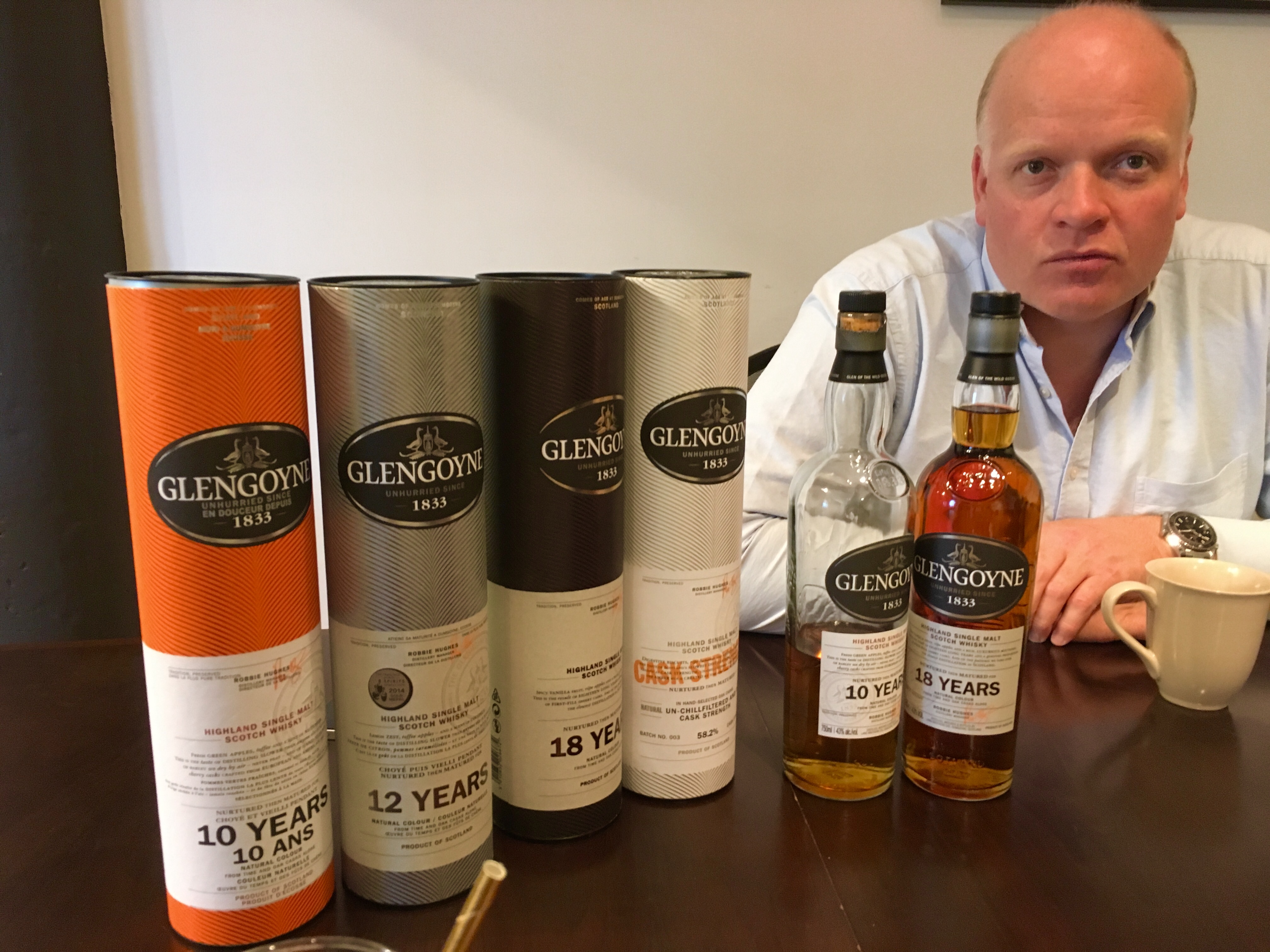Considering the obvious occupational hazards, Gordon Dundas of Glengoyne single malt scotch whiskies is remarkably well put together. Is it fate or serendipity that I’m attending a private tasting with Dundas at 10 am on the very day I’ll fly to Scotland, kicking off an extended European vacation? Or is it just bad luck? The vestiges of harsh minty toothpaste clash overwhelmingly with the first smack of sherry.

Wait. Did you just read ‘sherry’?
Is Dundas actually claiming this effete girly Spanish wine that the Queen Mother was pickled in for the last 40 years of her life affects the taste of my über-manly Scotch? Yes.
Here are five facts, maybe more — it was kinda early to be sampling — that Dundas shared about Scotland’s national drink, many of which may surprise you. Some of which may sound like heresy.
Fact One: three factors affect a whisky’s flavours. So, maybe that’s eight facts total … anyway, as I said, it’s still early. Fuck it.
The first factor, use (or non-use) of peat. According to the Wikipedia machine, ‘Peat, also called turf, is an accumulation of partially decayed vegetation or organic matter that is unique to natural areas called peatlands, bogs, mires, moors, or muskegs.’ Bogs? Moors?

Yes, many Scotch distilleries did and still do burn rotten swamp sludge, ‘also called turf’, to make their product. (Insert your predictable joke about thrifty Scots here, but many scotch bores refuse to shut up about the peaty whiskies, the author included.)
The use of peat is more common in the whiskies off Scotland’s wet (sic) coast. Despite its westerly location, just north of Glasgow, Glengoyne does NOT use peat.
The second factor, the shape of the pots. According to Dundas, the boilers’ contours ‘determine the distilling style’.
Third and most important factor ‘is the quality and diversity of the casks’. Whiskies are distilled in used barrels of European or American oak. Yes, your pure single malts are made in used booze repositories! Remember that stereotype of the thrifty Scot? It’s nay myth.
Fact One and 1/2: Only the Scots spell it whisky.
Consider Canadian rye, American bourbon and Irish, umm, well, whiskey. We all spell the word with an ‘e’ before the ‘y’. Did the Scots do this out of what many their call the sheer bloody-mindedness of their national character, or to save ink?
Whichever, let’s get back to the third factor, brought to you by those thrifty Scots.
200 years ago, Scotland’s southern neighbours had developed quite a taste for sherry, a fortified wine from Spain. The English often enjoyed it pre-supper, or pre-pre-supper, or even pre-launch. Even today, if you’ve ever walked along London’s miffy docks on a hot July morning, you’d want a powerful midmorning pick-me-up too.
Dundas: ‘Canny Scots, hanging around the London docks, saw all these empty sherry casks lying around and thought, there’s a cheaper way to store whisky.’ So, the decision to use used booze barrels was initially a financial one. ‘Then they tasted the product after it had been sitting in these casks. Mmm!’

At this point, Dundas pours a generous portion of the 10-year old Glengoyne. WHAP!! After the toothpaste taste in my mouth fades and I sip seconds? Mmm! says it all.
Noting my smile, this Scotsman waxes as richly about the flavours as a Burns ode to some maiden’s surrendered virginity: ‘Beautiful fruits: appley, beautiful smoothness, real balance; a little bit of richness from the sherry casks and a little bit of lovely toffee and butterscotch.’
Toffee? Butterscotch? Yes, just look at that amber colour. But we’re getting slightly ahead of ourselves.
Fact Two: In its initial distilled state, whisky is clear.
Whisky is essentially simple: a combination of malt, yeast and water. ‘Distillation in the pots produces a clear spirit.’ Like water. Small wonder the word comes from the Gaelic meaning water (or water of life depending on your translator). The result is ‘about 71% alcohol. Then it goes into the cask.’
And the effect of the given water on the flavour? Despite my long-held belief, Dundas calls it ‘negligible.’ Glengoyne’s water is from a reservoir that feeds into Loch Lomond (yes, that’s really a place).
The 10-year old is $65 a bottle. Which, while leading to our next point, catches us up just in time for the 12-year old dram.
Fact Three: All the colour and much of the flavour comes from the cask.
‘The cask has the strongest impact on the taste,’ says Dundas. What? Not the malt mash? Not the water? No. ‘Cask is king,’ he cutely puns.

Glengoyne distillers fill ‘all the casks with spirit and leave it for 10 years. So that’s sherry casks, bourbon casks and what we call refill casks. We fill them all for 10 years then marry them together to form our 10- or 12-year old and 18.’
Wait a second. Did he say ‘refill’ casks a minute ago? And aren’t single malts singular? Isn’t he blending different products? We’ll get back to this soon. At this point, I was still surprised by the importance of the cask on the taste.
‘Today, there’s such demand, casks are being made in Spain solely for Scotch.’ Glengoyne, whose business has been increasing consistently since its new owners acquired it a few years ago, is no exception. They have a sherry making partner who leaves ‘the casks to air-dry outside for 3 years.’
This is still in Spain, I ask, not yet notoriously rainy Scotland? He snorts: ‘In Scotland, they would never dry.’
At this point, we remind you of Dundas’s point regarding quality of the casks. An unsung but still important factor in the process is the cooper. Simply defined, coopers are barrel-makers, but they’re more of a combination of a carpenter, wood whisperer, mild pyromaniac and, ultimately, your oral DJ. The following is a direct quotation:
‘After 3 years of drying, the cooper does their magic and bends the staves into a cask. They toast the inside with fire, then put sherry in them for two and a half years — not so much to make sherry, but to get the tannins out of the wood that would ruin our whisky. So, you have a sherry-seasoned cask. Then the cask is transported to Scotland whole, not stripped back into staves. It makes for awkward transporting. You could transport twenty times the number if they were flattened.’

‘We’re paying a lot to transport air’ his boss once complained, but Dundas says it makes for a better product. Later that day, after his 10-, 12-, 18-year and cask strength samples have worn off, something hit me. Dundas never mentioned that transporting air circumvents the need to hire more coopers in Scotland which couldn’t be cheap. Canny Scots, indeed
Fact Three and ½: Single malt doesn’t necessarily mean better, just not blended.
There are about 120 single malt distilleries in Scotland, though not all are used in the production of brands. It simply means they haven’t been mixed. Why don’t all the distillers bottle and sell their own? Ask any mommy blogger: branding is hard work!
Many distillers choose to sell their single malt directly to brokers or other distillers, where it ‘ends up in blends like Johnny Walker.’ All of Glengoyne’s product goes into Glengoyne.
Fact Four: ‘Whiskies don’t get darker with age’ and age itself can be deceptive.
‘This is the biggest misconception about whisky.’ Leaving whisky in the barrel longer does little to affect the colour, which ‘comes in maturation early on and flattens out.’ He likens it to making tea, Scotland’s other national amber drink. A tea steeped for five minutes is the same colour as one minute, but the flavour is richer in the former.
Likewise, the size of the cask affects the colour. So, comparing whiskies of the same age is often moot. How so? Let’s revisit his surprisingly useful teabag analogy: Take two teabags from the same box. ‘Put one in a mug for a minute and another in a teapot for a minute. You’ll get completely different teas.’ They’re both 1-minute old teas from the same brand but so different, comparing them is almost pointless.
Similarly, not every whisky cask is the same size. Bourbon barrels are 200 litres. Some sherry casks are 500. So, when you mature the allegedly same product for 10 years in a small cask and another in a big cask, you get completely different whiskies.
Moreover, ‘it’s not age that makes great whisky.’ What!?? ‘It’s casks and age. And casks are the bigger influence.’
We’ve already talked about the cask’s importance, but just how important is it? Well, those allegedly thrifty Scots at Glengoyne pay up to $2,000 CDN per sherry cask! ‘But you can’t make whisky without them. So why would you scrimp on that?’ Speaking of which, at that price for an empty barrel, is it any wonder he’d also talked about ‘refill casks’?
Five: Many distillers, including Glengoyne, reuse reused used casks again! (Confused?)
That’s a lot to think about but I was prepared, albeit inadvertently. Initially, my friend Paul was to accompany me on this early morning tasting (ostensibly to make me look healthy) but he’d had to cancel at the last minute.
‘Sorry, man. I can’t afford to get morning drunk. Or, I mean, I can’t afford to get morning drunk, again. Or, really, I can’t afford to get morning drunk, again, today!’ I think he was joking.
The same mental gymnastics were required to get my fogging head around the ageing and mixing of Glengoyne’s single malts. Remember, they’ve bought used casks, to begin with, the Spanish ones specially made for their process. Meanwhile, ‘bourbon makers can only use their casks once. So that’s why they sell them.’ They reuse them. Then refill and reuse them again, getting less flavour and colour.
Remember the analogy: ‘If you use a teabag for the first time, you get a big flavour. If you leave it too long you get too much flavour. Whisky and bourbon can get like that.’ Reuse that cask and after 10 years you’ll get a very different whisky, with a different colour. ‘But when you combine them together… oh, the flavours.’
Canny Scots, indeed!


